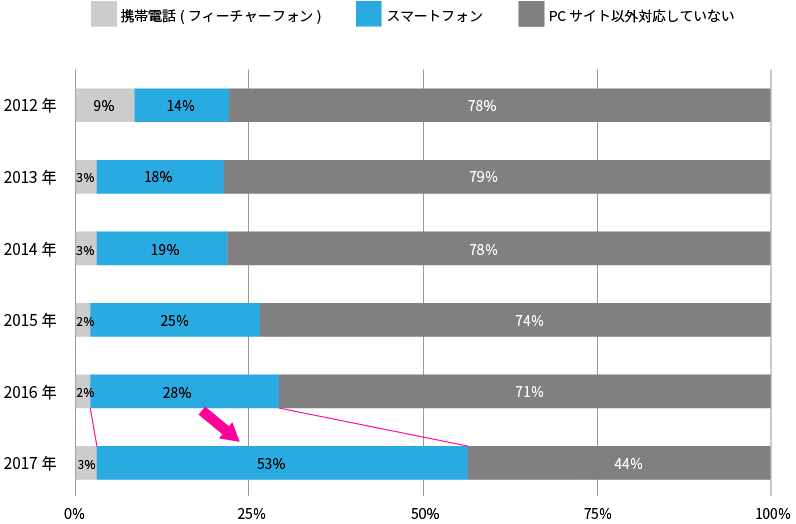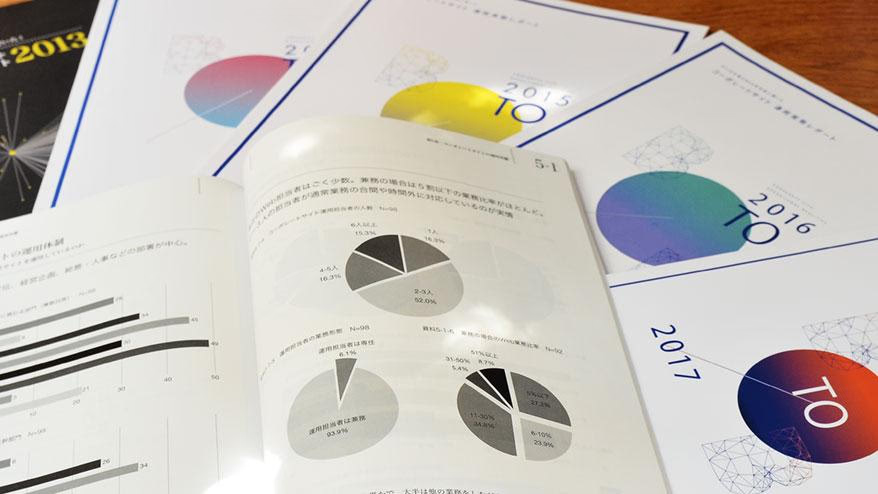Hello. I'm Haga from the BtoB team in the Marketing Department.
Our BtoB team has been producing a statistical report called the "Corporate Website Operation Status Report" since 2012.
The Corporate Website Operations Report (hereinafter referred to as the Report) is a compilation of actual situations compiled by directly interviewing website operations managers of B2B companies (listed companies or unlisted companies of similar size) mainly in the Tokyo metropolitan area.
We have reached out to companies that we have not had previous dealings with, one by one, and to date over 600 companies have agreed with the purpose of producing the report and have cooperated.
This time, I would like to tell you about what inspired our BtoB team to start producing these reports, the types of interviews we conduct, and the changes we have noticed in BtoB companies over the past five years.
Report production began with "no data."
We started specializing in corporate websites for B2B companies in 2012. Even before then, we had received requests from web managers at several B2B companies to "know the trends in corporate website operations" and "know how other companies are responding."
At the time, we were able to understand the trends of Internet users through publications such as the Internet White Paper and the Information and Communications White Paper, but there was almost no survey data that was "specifically aimed at those operating corporate websites."
As a team, we started a project to create a "Report on the Actual Operation of Corporate Websites" for BtoB companies, with the desire to "investigate the actual operation of corporate websites of BtoB companies and use the data in future website production." First, we made a list of target companies from quarterly reports and other sources, contacted each company one by one, and interviewed the people in charge of their websites to gather data.
We are proud to say that there are probably very few web development companies that have met and spoken directly with 600 web managers from B2B companies.

From the purpose of the site to the company structure,
We asked straightforward questions, including about the tools used and budget.
Here we will introduce you to the actual content we cover.
The interview items can be broadly categorized into the following six categories:
1. Overview of corporate website An overview of the company's websites, including the number of websites, the scale of operations, whether or not there are websites for overseas markets, and compatibility with multiple devices (PC/smartphone, etc.).
2. Purposes and goals of corporate websites Setting the purpose and goals of corporate websites, marketing utilization status, and trends in the utilization of log analysis tools.
3. Trends in CMS Use on Corporate Websites
Trends in CMS usage, including CMS implementation status, reasons and objectives for selection, and functions used.
4. Social media usage on corporate websites: What types of social media are used and for what purposes?
5. The actual state of corporate website operations The actual state of website operations, including the operational structure and outsourcing costs, update frequency and content, server operations, browser compatibility, and concerns of operators.
6. Current status of corporate website renewal projects: Details of renewal projects, including frequency and motivation for renewal, project budget and scope, structure and duration, and vendor selection.
By the way, this data is published in the form of numbers and graphs, and individual free-form responses are made anonymous, so the names of the companies we interviewed will not be identified.
In this survey, over half of the products were smartphone compatible.
With that, the budget also increased.
In fact, here is one trend that emerged from our latest report coverage.
The following graph shows the change in the percentage of corporate websites that are compatible with multiple devices from 2012 to 2017. The left side shows the percentage for mobile phones (so-called feature phones), the middle shows the percentage for smartphones, and the right shows the percentage for PCs only.

<Compatible devices other than PC (multiple answers possible)> *Comparison based on survey figures by year of publication of our report
Smartphone compatibility is increasing year by year, from 28% in 2016 to 53% in 2017.
Even among companies that currently only have PC websites, many of their web managers are interested in smartphone compatibility, including responsive web design (a technology that allows a single HTML file to be compatible with a variety of screen sizes, including smartphones and tablet devices), and there was an impression that they had a strong desire to implement this in their next website renewal.
In terms of budget, 70% of companies that fully renew their websites spend more than 3 million yen, with some even spending more than 30 million yen. Overall, 45% spend more than 5 million yen.
One of the reasons for this is that the adoption of responsive web design has resulted in higher initial costs.
Due to the influence of the mobile-first index (which evaluates and ranks search results primarily on smartphone sites), which was announced by Google last year and is expected to be fully implemented within this year, it is expected that compatibility with smartphones will become more and more common in the future. Accordingly, it is expected that renewal budgets will also increase further.
In order to make proposals that are unique to BtoB,
What we will continue to do.
When we visit B2B companies, we sometimes hear from their web managers that "We're B2B, so we don't expect much from our website," or "B2B company websites can't be viewed on smartphones, so there's no need for them to be mobile-compatible."
However, from 2012, when we started creating this report, to the present day, we get the impression that the attitude of web managers at B2B companies towards websites has been changing, albeit slowly. In fact, we have heard comments such as "Our business has expanded as a result of our website renewal" and "The atmosphere within the company has changed."
We were able to notice these changes in companies because we have been steadily conducting on-site interviews for five years. We feel that by directly asking the people in charge about the current state of website operations at B2B companies and grasping the latest trends, we can make proposals that are based on the perspective of B2B companies.
We will continue to cover the situation and, as "BtoB experts" who are always aware of on-site trends, we will be the team that is more knowledgeable about web trends in the BtoB industry than anyone else. I think that is our role.
If you are a web manager at a B2B company who has read this article and is curious about the contents of the report or would like to know the situation at other companies, please feel free to contact us.
03-5308-1510
or
Contact form
Please feel free to contact us.
(Responsible person: Haga or Furihata)

